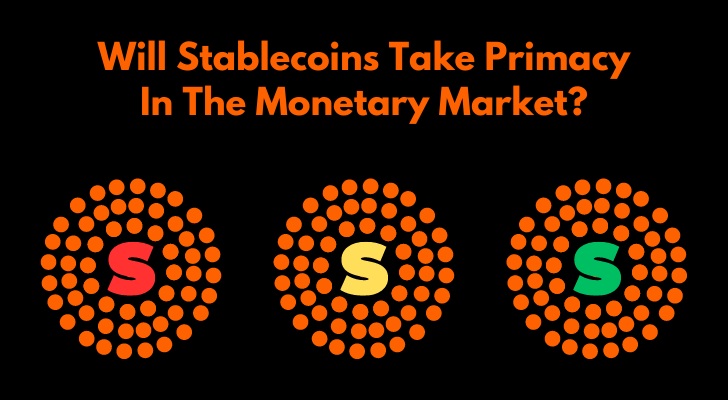The crypto world has long been abuzz with talk of stablecoins. They can possibly transform the entire industry in the near future. With their ability to provide real-world value and stability amidst high volatility in traditional cryptocurrencies, they could be the stepping stone that takes digital assets from being an investment vehicle to becoming a viable form of currency - a game changer for the global economy.
So let's find out how stablecoins could affect both traders and governments, as well as whether or not these digital tokens will dominate the monetary system. Read on to learn more.

What Are Stablecoins?
A stablecoin is a type of cryptocurrency that is pegged to a stable asset, such as gold or the US dollar. The purpose of a stablecoin is to provide a cryptocurrency that is less volatile than other cryptocurrencies, such as Bitcoin. Many digital asset investors believe that stablecoins will eventually take over traditional fiat currencies, such as the US dollar, as the primary form of currency.
How Do Stablecoins Work?
So here are the ways to peg a token’s value to that of another asset.
The most common is probably through an algorithmic reserve, where the price is stabilized by holding crypto in a reserve and using smart contracts to expand or contract the money supply (this is how Basis works).
Other mechanisms include collateralized debt positions, or even simply pegging it 1:1 with fiat currencies or other assets.
The key advantage that stablecoins have over traditional fiat currencies is that they can be sent and received instantly, and transactions are recorded on an immutable blockchain. This makes them much more efficient than traditional banking systems, which can take days or even weeks to process international payments.
Because stablecoins are built on decentralized protocols, they are immune to government interference or manipulation. This could make them ideal for countries with unstable economies, as well as for people who want to hedge against inflationary risks.
Tether (USDT)
Tether (USDT) is probably the best-known stablecoin, issued on the Bitcoin blockchain via the Omni Layer Protocol. It was created to facilitate transactions between crypto exchanges and provide users with an easy way to store value without having to convert it into fiat currency.
It means that the Tether’s value is pegged 1-to-1 with the US dollar, meaning it will always remain worth one US dollar even when other cryptocurrencies fluctuate in value. Tether offers;
- Transparency and security through its open-source platform, allow users to easily monitor their transactions and account balances.
- It can be used for trading purposes on most popular exchanges as well as investing in other digital assets or sending payments across borders in real-time securely without any third-party interference.
USDT provides an efficient, cost-effective way of transferring funds globally, and its use has grown rapidly since its launch in 2015. As a result, USDT is one of the most widely used stablecoins in the crypto space and can be found across many different platforms including exchanges and wallets.
Join The Most Trusted Cryptocurrency Platform For Free
Other Major Stablecoins
USDC, PAX, BUSD and DAI are some of the other major stablecoins to maintain a consistent price relative to the US Dollar.
USDC (USD Coin)
USDC is an Ethereum-based token issued by the CENTRE consortium with each token representing one US dollar in reserve, developed and issued by Circle, in collaboration with Coinbase.
Through its open-source platform, USDC provides users with access to financial services such as low-cost payments and store-of-value functionality without the need for custodians or third parties.
PAX (Paxos)
PAX was created by Paxos Trust Company and launched in September 2018 as an Ethereum-based ERC-20 token. The coin is regulated by both the New York State Department of Financial Services and the Gibraltar Financial Services Commission, making it one of the most highly regulated cryptocurrencies available on the market today.
PAX users benefit from faster transaction times and lower fees than traditional fiat currencies. Paxos ensures that holders can make transfers without worrying about significant losses due to price volatility like other digital assets such as Bitcoin or Ethereum may suffer from.
BUSD (Binance USD)
BUSD is a stablecoin created in partnership between Binance, the world's largest cryptocurrency exchange, and Paxos Trust Company. It is also designed to bridge the gap between traditional fiat currencies and digital assets. It offers users increased liquidity, improved transparency and faster settlement times as compared to other payment methods such as ACH transfers or wire transfers.
The coin also offers a secure store of value for holders who are looking for an alternative to holding their funds in volatile digital assets or risky bank accounts.
DAI (Dai)
DAI is an Ethereum-based decentralized stablecoin created in 2018 by MakerDAO. It uses an algorithmic system that monitors Ethereum’s price and adjusts its own supply accordingly. This ensures that one DAI will always equal one dollar in value, allowing users to make secure transactions while keeping their savings safe from market volatility.
DAI is decentralized and can be used anywhere in the world where Ethereum is accepted, making it an ideal option for those looking for low-cost international remittances or payment services.
All four coins offer traders a way to hedge against volatile crypto markets while avoiding having to convert back into traditional currencies like USD or EUR. By pegging their value 1:1 with USD, these coins provide a stability that can help businesses avoid losses incurred when prices drop unexpectedly.

Backed By Assets
Stablecoins are “backed by assets” - Assets mean fiat currencies, gold, or other commodities.
The token issuer must hold an asset in reserve and use it to back each coin that is issued. This means that even if the price of the underlying asset fluctuates, the value of the stablecoin will remain steady and not be affected by those changes in market prices.
This makes stablecoins particularly attractive for users who want to protect their funds from market volatility while still enjoying all the benefits of using cryptocurrencies such as ease of transfer and low transaction costs.
Stablecoins provide an effective way to hedge against risk without having to give up on digital currency use altogether. That’s why investors can feel comfortable investing in these digital tokens without worrying about extreme price swings or market volatility.
Also Read: Crypto Quantum Leap Review – The Best Cryptocurrency Course?
Lower Transaction Fees
Stablecoins are designed to be pegged to a stable asset, which means that they can hold their value over time without being subjected to the same volatility of major cryptos like Bitcoin which can see prices fluctuate significantly in a short space of time.
As a result, using a stablecoin will often mean paying less in terms of fees when carrying out transactions compared to other digital currencies.
As more people turn towards digital assets such as stablecoins in order to make payments it is likely that they will become the preferred option due to their low cost, speed, and reliability.
The Disadvantages of Stablecoins
So far, I’ve been talking about all the advantages of stablecoins, but there are, of course, some drawbacks.
Centralized
One of the biggest disadvantages is that they are centralized, which goes against the decentralized ethos of cryptocurrency. This means that they are subject to manipulation by their issuers and can be frozen or confiscated by governments or financial institutions.
They can be vulnerable to hacking because if a centralized platform is hacked, then all of the users’ funds on that platform are at risk.
Lower Liquidity
Stablecoins tend to have lower liquidity compared to other cryptocurrencies due to their limited use cases. Stablecoins are designed to maintain a stable value, making them less attractive for day traders who look for variations in the market. This leads to fewer people trading with these tokens and therefore lower overall liquidity.
Market Fluctuations
Being pegged to an asset means stablecoins may be subject to its market fluctuations. Depending on their structure, they can still have volatility due to demand and supply dynamics or other external factors.
Furthermore, the stability of a stablecoin depends on how well it is backed by assets in reserve; if these reserves become insufficient then the value of the stablecoin could decline.
Not Regulated Well
Since many stablecoins lack proper regulation there is potential for fraud and manipulation which could severely damage investor confidence in them.
For that reason, if the issuer of a stablecoin fails or goes out of business, then the value of the coin could drop significantly.
Since most governments prefer fiat currencies for payments and transactions over cryptocurrencies like stablecoins this increases their riskiness as investments altogether.
Join The Most Trusted Cryptocurrency Platform For Free
The Future Of Stablecoins
In the future, economic experts believe that stablecoins will play an increasingly important role in the global monetary system. They offer many advantages over traditional fiat currencies, including 24/7 access, near-instant settlements, and greater price stability.
The combination of these factors will eventually lead to stablecoins taking primacy in the global monetary system.
*** What Does "Pegged" Mean?
In cryptocurrency, "pegged" refers to a currency exchange rate that is held at the same value as another currency.
For example, if one crypto coin has been pegged to the US Dollar (USD), then its price will remain equal or close to the price of 1 USD.
This allows traders and investors to hedge their investments against fiat currencies such as the USD, Euro and GBP.
By pegging a coin's value against a fiat currency, it gives users more stability when trading cryptocurrencies since they know exactly how much their coins are worth in terms of that particular fiat currency.
Will Stablecoins Take Primacy In The Monetary Market?
The future of stablecoins may be uncertain, but it's clear that the technology and potential applications will continue to be explored. Stablecoins have the power to simplify and secure financial transactions, providing a simpler and more secure medium for storing value and making payments.
The combination of blockchain technology with asset-backed tokens holds great promise in terms of increasing trust, access, and transparency in financial markets around the world. Ultimately, only time will tell if stablecoins take primacy in the monetary market or not.
Did You Know You Already Have A LOT To Sell?
So What's Your Problem?

